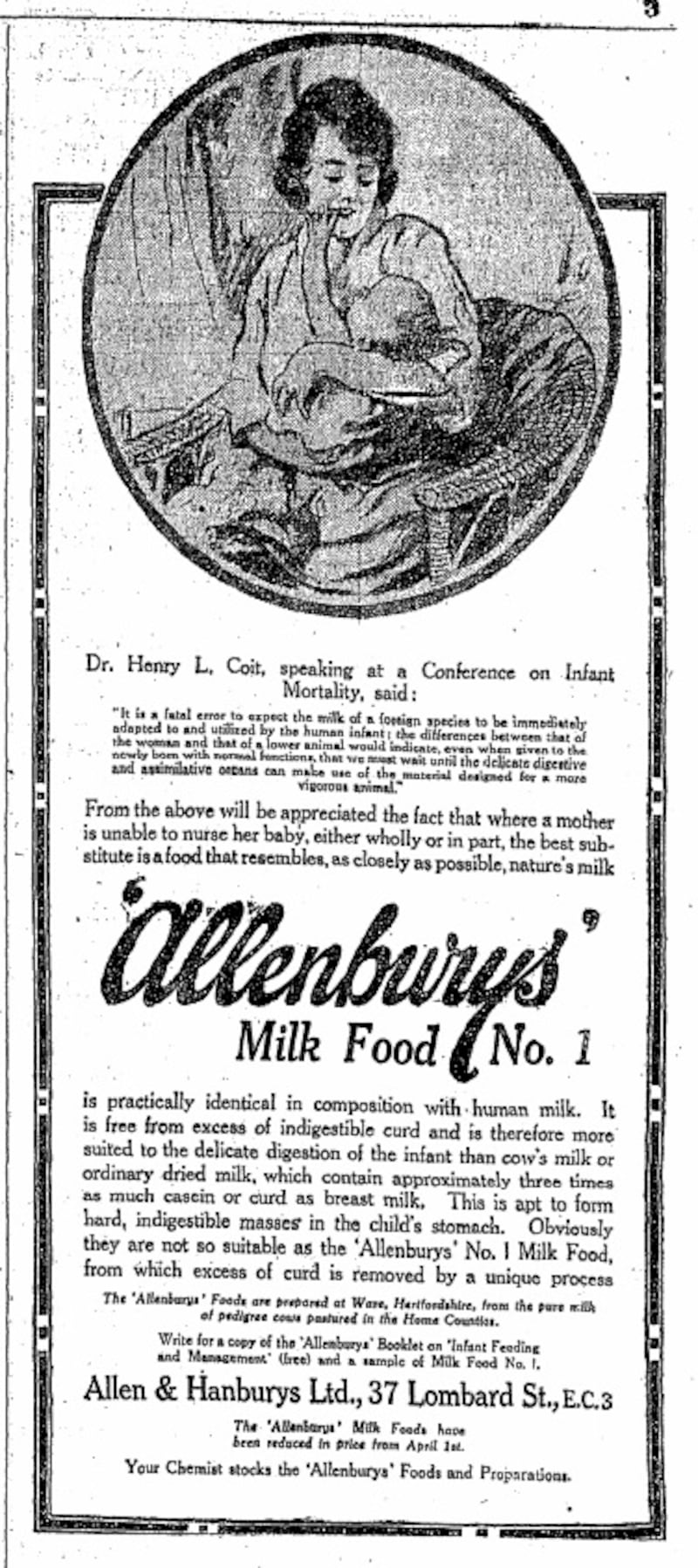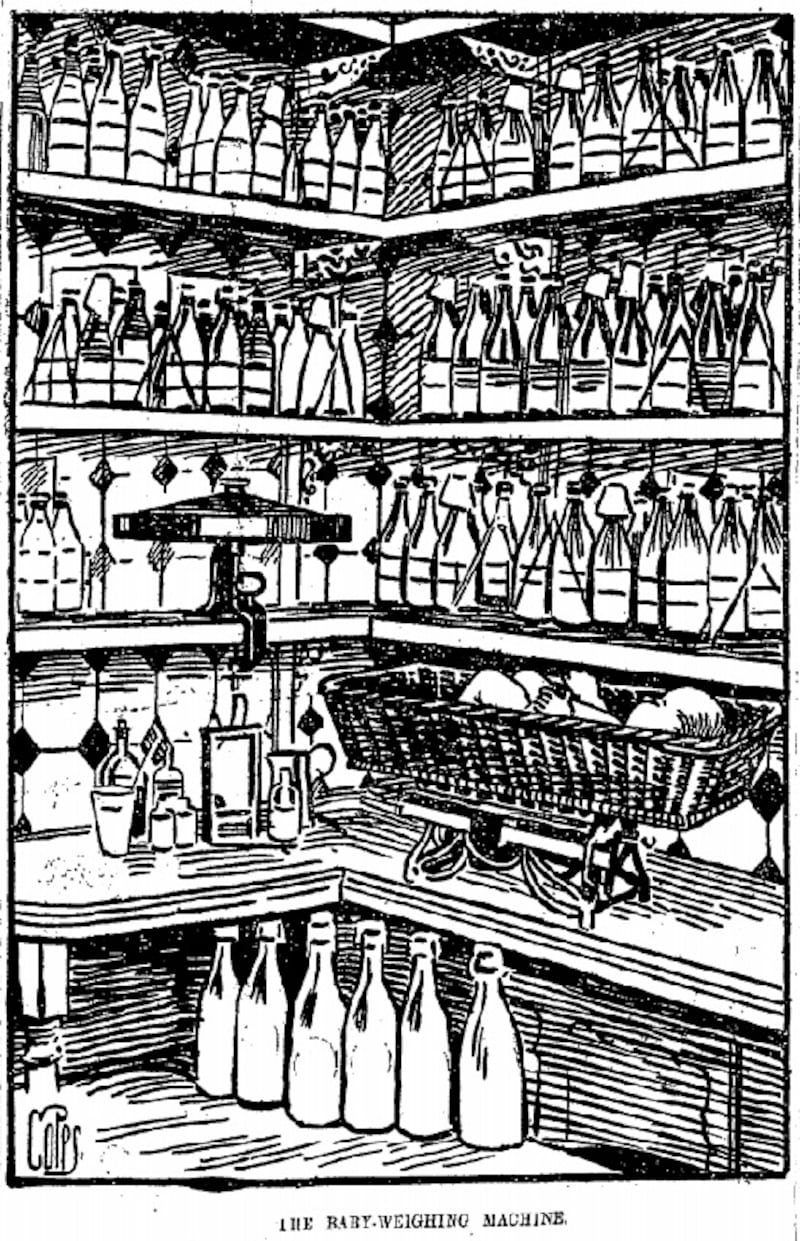Links between how babies are fed, and their health, are long established, and efforts to increase breast-feeding rates date back to the 19th century, when the nutritional needs of infants and new mothers were already under scrutiny – and the focus of advertisers.
For almost six decades from 1859, classified notices in The Irish Times were used to find women to breastfeed children, or to seek employment as a wet nurse, as Mary McMahon from Dolphin’s Barn did in 1861: “A Young, healthy, Woman, lately confined, is anxious to get a respectable child to Wet Nurse. She lives in an airy country place, with a few minutes walk of the city boundary, and can be well recommended.”
Poignant messages illustrate that mothers, whose own babies died, hired themselves out: “A Woman lately confined of her fourth child, which is dead, wishes to get a baby to wet nurse in her own house . . .”; “A healthy Young Englishwoman (a Protestant) who has just lost her own baby, would undertake of the care of another of respectable connexion: her house is in a healthy part of the city”.

Dry nurses were also in demand for “artificial feeding”, like the lady in 1861 who could “take care of a baby from its birth, and is well experienced in spoon and bottle-feeding”. For while some mothers were unable to breastfeed, there was a growing trend among the upper classes not to nurse, provoking medical concern.
In 1877, this paper published an extract from medical journal The Lancet on the topic: “The evils attendant upon the artificial rearing of children are so great and so well known to the profession that it is not a little surprising the custom continues so fashionable. Instances of permanent injury to health and even of death from this cause daily come under the notice of medical men, and every now and again the mortality amongst nurslings brought up in this matter attains such magnitude as to be perfectly appalling . . . It is not so rife amongst the poor as it is amongst the well to do and fashionable . . . It cannot but be believed that were mothers aware of the magnitude of the evils arising from abstinence from nursing, not only to their infants, but to themselves, much less would be heard of the bottle, and the endless variety of patent foods with which it was filled, and much more of that natural food which is the rightful property of the infant – the mother’s milk.”
Some of those patent foods included Neave’s Food, produced since 1825, which used ‘testimonials’ of ailing babies transformed into baby show winners in its regular advertisements, and claimed it was used in the Russian Imperial Nursery.
Poorer mothers
Poorer mothers, meanwhile, were unable to breastfeed when they needed to return to work. In 1893, ‘Free Lance’ wrote about three day nurseries used by Dublin’s working mothers “Some are tailoresses, some laundry women, some charwomen, and some go to factories”. Children from the age of a month to five years were minded for a penny a day. Mothers were allowed to “nurse the babies when they can manage it” but it was not usual, our reporter was told.
Victorian doctors sometimes prescribed dried milk products when a mother was unable to nurse, as it was often regarded as a safer alternative to unsuitable condensed milk, or cow's milk, which could be contaminated, adulterated, and soured. In addition, unclean bottles and teats represented a huge sanitary risk, and many early bottles featured rubber tubes, an additional breeding ground for germs. Professor of hygiene and Dublin's public analyst Sir Charles Cameron described them as "objectionable and dangerous" in 1904.

That September, following an epidemic of diarrhoea and dysentery, Cameron reported that most infant deaths were among “bottle-fed” babies: “due to the use of improper food and ‘milk improperly kept’ overnight “on the window sill . . . the landing, a coal-hole, on the hob &c”. In addition to milk, many children who died had been given “other foodstuffs which was unsuitable . . . porter, sweets, cakes, cabbage, meat, fish, potatoes, various kinds of artificial foods, rusks, bread and butter, and fruit”.
What was considered acceptable to feed babies constantly changed, sometimes not for the better. In 1902, Horlicks claimed that a child fed on their malted milk powder “will sleep well, grow well, and flourish exceedingly”. In 1903, an ad for Grape-Nuts declared that the life of a child whose stomach had been ruined by condensed milk, was only saved by a preparation made from the cereal. And St Ivels cheese in 1911 was purported to have saved the life of a vomiting three-month-old infant when “nothing else would stay down”. An advertisement from 1919 proposed mixing Robinsons barley water with dried milk.
In 1905, Dr William J Thompson reckoned "that fully three-fourths of the deaths of children under 12 months of age occur amongst those who were fed artificially". Describing some of the impure and adulterated 'milk' sold as "rank poison", Dr Thompson advocated the establishment of subsidised, sterilised milk depots.

Milk depot
The first pasteurised milk depot, opened by the Women’s National Health Association in Dublin’s Arbour Hill in 1908, produced four “special preparations for children” up to nine months old, some containing “barley water, and in addition, cream and sugar in different proportions”.
However, the variety of infant foods and formulas continued to increase, with many producers preying on the insecurities of new mothers about how their baby was thriving. Allenbury’s Milk Food No 1 claimed to be “practically identical in composition with human milk”. Glaxo “builds bonnie babies” was promoted as “The only Food that has been used in Five Royal Nurseries”.
Even throughout the 1930s and 1940s, Cork’s medical officer, Dr JC Saunders, blamed a disinclination to breastfeed, and “the perils in every method of artificial feeding”, for ongoing infant deaths from gastroenteritis. In 1949, he wrote: “For years, I have been inveigling against the practice of bottle feeding, and now feel that, until such time as the medical and nursing profession become alive to their responsibilities in this matter, we will make no substantial headway in reducing infant mortality.”
Meanwhile, the nourishment of mothers who did nurse was a regular topic. Products which purported to support breastfeeding included Dr Tibbles Vi-Cocoa – made from Kola nuts and cocoa – in 1898; Ovaltine, a malted flavouring for milk; and even Lucozade.
A 1957 ad claimed that Mrs HB from Co Leix had survived on the liquid alone for 12 days, and successfully nursed her baby.










